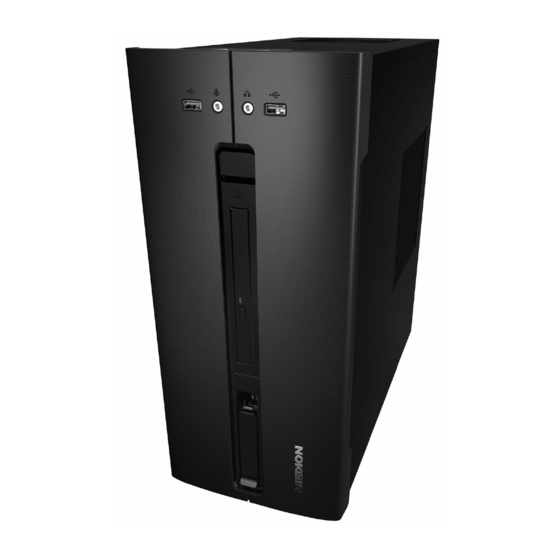
Table of Contents
Advertisement
Advertisement
Table of Contents

Summarization of Contents
Information About Operating Instructions
Key to Symbols
Explains warning symbols used in the manual to denote hazards and their potential consequences.
Proper Use
Details the intended use of the information electronics device and restrictions on modifications or unauthorized accessories.
Trademark Information
Lists trademarks and registered trademarks relevant to the product and its software, including Windows, Intel, AMD, and HDMI.
Safety Information
Dangers for Children and People with Reduced Ability to Operate Devices
Outlines safety precautions for children and individuals with limited physical or mental abilities when using the device.
Operating Safety
Provides essential safety guidelines for reliable PC operation and to prevent hazards from damage or misuse.
Never Carry Out Repairs Yourself
Warns against attempting self-repairs due to the risk of electric shock and advises contacting authorized service.
Data Backup
Emphasizes the importance of backing up data to external media before updates to prevent loss.
Mains Cable and Power Supply
Instructs on connecting the power supply, socket accessibility, and safe unplugging procedures to prevent hazards.
Mouse Safety
Covers safety precautions for using the mouse, including eye protection from laser and handling guidelines.
Audio Connections Safety
Warns about potential hearing damage from high volume levels when using headphones or speakers.
Optical Drive Safety
Provides safety notices regarding the optical drive, highlighting laser classification and media handling risks.
Setting Up the PC
Installation Location
Guides on selecting a suitable, stable, and vibration-free surface for PC installation, avoiding environmental hazards.
Ambient Conditions
Specifies the recommended operating temperatures and humidity levels for the PC to ensure proper function.
Ergonomics
Offers advice on monitor placement and posture to avoid eye strain and physical discomfort during use.
Connection
Connecting the Cables
Provides instructions for safely connecting cables, including distance from interference sources and avoiding damage.
Connecting the Monitor
Details how to connect the monitor using VGA, DVI, DisplayPort, or HDMI, with connection precautions.
Connecting HDMI Devices
Explains connecting HDMI devices for the fully digital transfer of audio and video data.
Connecting USB Devices
Guides on connecting USB devices, emphasizing initial setup and proper plug insertion to avoid damage.
Connecting Audio Output/Headphones/Speakers
Covers connecting audio output devices like headphones and speakers, including surround sound setup.
Connecting a Microphone
Details how to connect a microphone using a 3.5 mm jack plug to the front PC socket.
Connecting Audio Input/Recording Source
Explains connecting external analogue audio sources like synthesizers to the PC.
Connecting a Network (LAN)
Provides instructions for connecting to a network using an RJ45 Ethernet cable.
Connecting the Power Supply
Guides on connecting the PC and monitor to the power supply and safely unplugging.
First Use
Operating LED Responses
Explains the meaning of different LED states for system operation and power saving modes.
Starting Up the PC
Provides step-by-step instructions for powering on the PC and initial system setup procedures.
Activating Antivirus Software
Details the automatic activation of pre-installed antivirus software and its benefits for system protection.
Mouse
Left Button
Explains the function of the left mouse button for selection and confirmation actions.
Right Button
Describes the function of the right mouse button for accessing context menus and commands.
Scroll Wheel
Covers the functions of the scroll wheel for navigation and its use as a third button.
Keyboard
The Alt, Alt Gr and Ctrl Buttons
Explains the use of modifier keys like Alt, Alt Gr, and Ctrl for special characters and commands.
The F1 to F12 and Fn Keys
Details the function keys (F1-F12) and Fn key for executing commands, help systems, and OS functions.
Hard Drives
Important Directories
Lists and describes essential system directories on the hard drive, warning against deletion or modification.
Hot-swap Mobile Rack
Explains how to install a 3.5" hard drive into a hot-swap SATA mobile rack.
Optical Drive
Load Disc
Provides instructions and warnings for loading discs into the optical drive, emphasizing media quality.
Removing the Disc
Details the procedure for safely removing a disc from the optical drive.
Emergency Removal of a Blocked Disc
Explains how to manually open the optical drive tray for emergency disc removal.
Playing/Reading Discs
Describes the functionality of playing audio CDs, DVDs, and data discs, including region coding.
Handling Blank CDs and DVDs
Offers advice on handling blank CDs and DVDs to prevent damage from environmental factors like sunlight.
Card Reader
Inserting the Memory Card
Guides on inserting memory cards correctly into the card reader, warning of potential damage.
Removing Memory Cards
Explains the correct procedure for removing memory cards using software actions to prevent data loss.
Network Operation
Network Connection
Instructs on connecting the PC to a wired network using an RJ45 Ethernet cable.
Wireless LAN (Wireless Network)
Covers the setup and usage of the PC's integrated wireless LAN (WLAN) capabilities.
Bluetooth®
Explains Bluetooth technology for wireless device communication and its operational considerations.
System Recovery/Settings
Resetting the PC to its Factory Settings
Details options for reinstalling Windows and restoring the PC to its original factory state.
System Recovery with Windows Recovery Options
Explains how to refresh or reset the PC using Windows recovery options to resolve issues.
UEFI Firmware Configuration
Guides on accessing and modifying the UEFI firmware settings for system configuration.
Customer Services
Initial Help in the Event of Hardware Problems
Offers initial troubleshooting steps for hardware malfunctions and contact information for support.
Finding the Cause
Provides steps to diagnose hardware issues, starting with checking cable connections and power supply.
Faults and Possible Causes
Lists common faults like black screen, incorrect time, or PC not starting and their potential causes.
Do You Need More Help?
Advises on further assistance, including online help guides and hotline contact information.
Driver Support
Explains that drivers may need updating due to compatibility issues with other components.
Upgrades/Modifications and Repairs
Information for Service Technicians
Provides essential safety and procedural information for service technicians performing repairs or upgrades.









Need help?
Do you have a question about the AKOYA P32010 and is the answer not in the manual?
Questions and answers